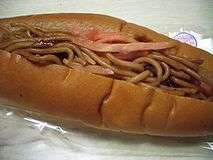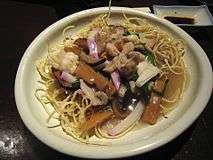Yakisoba
.jpg) | |
| Type | Japanese noodles |
|---|---|
| Place of origin | Japan |
| Main ingredients | Noodles (wheat flour), Worcestershire sauce, pork or chicken, vegetables (usually cabbage, onions or carrots) |

Yakisoba (Japanese: 焼きそば [jakiꜜsoba]), literally "fried buckwheat", is a Japanese noodle stir-fry dish. Although soba means buckwheat, yakisoba noodles are actually made from wheat flour, and are typically flavored with a condiment similar to oyster sauce. The dish first appeared in food stalls in Japan during the early 20th century.[1]
Preparation
Yakisoba is prepared by frying ramen-style wheat noodles with bite-sized pork, vegetables (usually cabbage, onions or carrots) and flavored with yakisoba sauce, salt and pepper. It can be served with a variety of garnishes, such as aonori (seaweed powder), beni shōga (shredded pickled ginger), katsuobushi (fish flakes), and mayonnaise.
Serving
Yakisoba is most familiarly served on a plate either as a main dish or a side dish. Another popular way to prepare and serve yakisoba in Japan is to pile the noodles into a bun sliced down the middle in the style of a hot dog, and garnish the top with mayonnaise and shreds of pickled ginger. Called yakisoba-pan (pan meaning bread) it is commonly available at konbini (convenience stores).
Sometimes, Japanese udon is used as a replacement of Chinese style soba and called yakiudon. This variation was started in Kitakyushu or Kokura in Fukuoka Prefecture.
In Okinawa, yakisoba is popular with Okinawans and U.S. service members stationed on the island alike. After the 1945 hostilities ended on Okinawa, the US military command supplied American food products to the malnourished residents. Yakisoba was prepared from spaghetti, spam, ketchup, any available vegetable (usually canned), and mayonnaise. Mess halls and other on-base eateries often serve yakisoba. Chopped hotdogs are a popular addition to yakisoba made on Okinawa, in addition to other meats such as ham, chicken, and pork.
- Yakisoba dishes


See also
References
| Wikimedia Commons has media related to Yakisoba. |